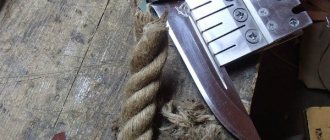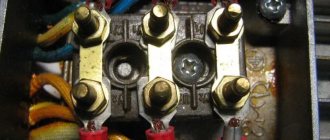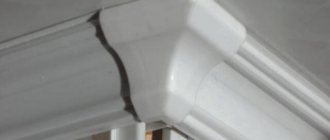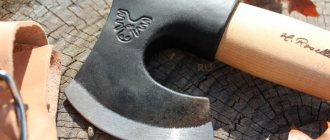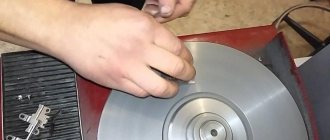When carrying out work on the installation of gas or water mains, it often becomes necessary to change the direction of the line, while the pipeline is cut and then welded at the desired angle. Most often, the direction changes by 90 degrees, and the question arises - how to cut the pipe at 45 degrees in order to accurately connect the joints when welding.
You can cope with the problem of cutting edge angles of 45 or 90 degrees if you have the appropriate knowledge and techniques that will help save not only time, but also materials during the work. At other rotation angles, it is impossible to solve the problem using a ruler and a sheet of paper; you will have to call computer technology for help.
Fig. 1 How to cut a pipe at an angle of 45 degrees
How to cut at 45 degrees
- - miter box;
- - construction square;
- - pencil;
- - hacksaw;
- - sharp knife;
- - metal ruler.
Most often you have to cut the baseboard for the internal corners of the room. To trim, place it in a miter box fixed in a stationary state. Press the very edge a little further than the slot at the 45 degree mark located on the right. Cut the baseboard using a hacksaw blade. If its long part is on the right, the cropped corner will be right-handed, respectively, on the left - left-handed.
Remember that the side of the plinth that is pressed against the side wall of the miter box when cutting the corner will be glued to the wall during installation, and the side that is pressed against the bottom of the miter box will be glued to the ceiling. After cutting off two corners: left and right, place the product in the corners to check the accuracy of the cuts made. Correct minor discrepancies using a sharp knife.
External corners are less common in apartments. When cutting the baseboard to create such corners, you must first make a mark at the beginning of the outer corner. To do this, use the markings to press the product against the wall and use a pencil to mark the edge of the corner of the wall where the cut will be made. Please note that before applying the mark, the baseboard must be prepared for gluing, that is, have an internal corner or be ready for direct joining.
Place the plinth in the miter box and press down. If its long part is located on the left, make a cut along the left mark of the miter box, corresponding to an angle of 45 degrees. The side pressed against the side wall, as when cutting an internal corner, will be glued to the wall during installation.
When gluing, make sure that the bottom side of the outer corner matches the outer corner of the wall or protrudes slightly beyond it. Cut the right side of the corner in the same way.
To cut an angle on a wide plane, use a square. Place it so that the inside fits snugly against the end of the product.
How to cut a 45 degree angle without a square and a protractor
Methods
In addition to cutting using a miter box, in which the angles are clearly defined (90, 45, sometimes 60 degrees), there are other methods. More expensive is to use a rotary miter box or rotary circular saw. Cutting an angle with a tool like this, where it can be adjusted and is fairly easy to install, is not difficult. Cutting is done either manually or using a circular saw.
Purchasing such equipment for finishing one room, bathroom or even an apartment is hardly justified; professional activity is another matter, in this case, of course, it is better not to save.
In order to file a fillet at home, you can get by with a more budget-friendly option by preparing a homemade miter box from plywood. It is important to clearly measure the corners and make cuts along which the plinth will be sawn off in the future.
In order not to confuse the sides of the plinth and to cut correctly, at first it is better to apply it together with the miter box to the ceiling; gradually the skill will be developed and you will be able to do without repeated movements up and down.
You can also prepare a kind of mock-up of the miter box on cardboard; the sawn-off plinth will have to be placed on the mock-up and marked with a pencil. In order to cut the required angle, it is better to move it to a more convenient place; in addition, it is important not to spoil the layout.
There are ways to saw off corners without a miter box. This is especially true since the angles are not always ideal, and the standard angle of 45 degrees may be incorrect. In order to make a corner in this way, you need to place a piece of plinth directly on the ceiling exactly as it will be mounted. Use a pencil to mark the width of the fillet on the ceiling. Having placed the baseboard on the other side of the corner, you also need to mark its width on the ceiling.
You will get two intersecting segments. Then you need to again attach the pieces of plinth to the ceiling and mark the same point on them.
It is necessary to cut from the edge to the marked point; it is important to remember the sides with which the plinth will be adjacent to the wall and ceiling; under no circumstances should they be confused. Small flaws can be corrected during the installation process, trimmed with a stationery knife, if the baseboard material allows this. With wooden fillets everything is much more complicated; a knife will not help there.
READ What Torque Does a Screwdriver Need?
“On-the-spot” measurements make it possible to cut both internal and external corners without large losses, although the latter are not common, yet their finish is significantly different.
How to cut the ceiling plinth at 45 degrees, see below.
External corners
It happens that a room has not only internal, but also external corners, which also need to be covered with plinth (see photo). How to do it? There are several ways here too. The easiest way, as in the case of internal corners, is to trim them using a miter box. The external joints must be cut so that the side that will be glued to the ceiling is on the surface of the miter box, and the side pressed against the wall is facing the wall of the device.
As in the case of internal corners, you can also use markings “in place”, that is, draw a mowing line on the ceiling. Here the technology exactly repeats that used for internal corners.
You can use markings on the wall by attaching a blank and drawing a line along its lower edge (see photo).
If the outer corner turns out to be too rounded, you can refine the joint using a knife.
READ How to cut a magnet at home
Cutting ceiling plinth. External and internal corners
To the point where they meet, a fishing line is drawn directly along the future part of the connection. From the point on the ceiling to the second one. The resulting marking will be the line along which you need to saw off or cut off the connecting parts. Using these techniques, you no longer have to wonder how to cut the corners of the ceiling plinth.
How to cut a 45 degree angle: How to cut a 45 degree angle
Trimming using a miter box
How to evenly trim the corner of a ceiling plinth using it?
A miter box is a simple tool used by carpenters. With its help, you can cut any workpiece at the desired angle.
It is usually a wooden, metal or plastic tray on which special vertical slots are made for cutting at an angle of 45° and 90°.
There are complicated designs, which, in addition to the mentioned angles, also have a hole for making a 60-degree cut.
A special miter box is produced for professional work. Its rotating mechanism allows you to fix the cutting blade in relation to the workpiece at any given angle.
How I glued plastic corners to the wall and windows.
The process of trimming skirting boards to go around internal and external corners in a room is simple, but requires precision in execution. The video below provides you with additional information on this topic.
Technology for cutting pipes at right angles
If we exclude the options used in industry - dies with mandrels, devices for radial cutting - then there are not many solutions available to the home craftsman. In any case, you will need either a hacksaw or a hand grinder. The adjustment is facilitated by the fact that the tubular product always has only linear contact with the cutting plane.
How to saw off a metal pipe smoothly? It is enough to firmly clamp the metal workpiece with parallel clamps, mark the cutting area with a marker and cut it to size. Of course, within the gaps between the hacksaw blade and the mounting bases of the hacksaw, play is always possible, resulting in a burr on the joint surface. If subsequently the inclined section of such a joint is joined to another element of the pipeline using manual arc welding, then this is not a problem: everything can be corrected (within reasonable limits) by changing the thickness of the weld. Otherwise, you should simply select a new tool and constantly monitor the marker markings during the cutting process.
It’s even easier to cut the end using a pipe cutter (it’s inexpensive, in extreme cases you can borrow it from a more skilled neighbor). This tool is equipped with a special screw-type feeding device. The sequence of actions using a single-roller pipe cutter is as follows:
- The surface of the workpiece is thoroughly cleaned of traces of dirt, grease or scale.
- The divided area is tightly compressed with jaws (if the pipe is made of soft metal, for example, aluminum, it is better to place a rubber corrugated plate between the jaws: the clamping friction will increase).
- By rotating the feed screw, the cutting roller is gradually inserted into the wall until the roller cuts through it.
- Change the position of the round pipe, rotating it 1200 so that the cutting roller comes into contact with the new cut section, and repeat the transition.
- We perform one more reinstallation - and the straight section of pipe is ready. All that remains is to clean the areas of the overlap.
There are three- and four-roller pipe cutters, where the cutting process is quite simple, since the number of reinstallations is correspondingly reduced.
How to cut steel pipe at 45 or 90 degree angle? First, you should check whether the pipe cutter you already have is suitable for sawing a particular part. The following are taken into account:
- Strength limit of the material;
- Diameter or wall thickness;
- The condition of the cutting edges of the roller/rollers and the gaps in their axes.
Note: In especially critical cases, you should first practice on an unnecessary piece of pipe.
How to form an angle?
Lay the cut tiles on the corner so that they look perfect, which is important, since the profile of the connecting edges has been changed and it is necessary that the tiles fit together evenly at the joint.
- The first tile is glued, the position is fixed with a level, the cut edge goes beyond the edge of the wall, which is normal.
- While the glue has not hardened, the tiles are glued to the other side of the wall, the cut edges are tightly connected, and then the tiles are glued in this order.
- It is important that the wall is level on both sides, otherwise it will not be possible to form the correct angle with the help of tiles.
Laying tiles is no different from what is done during regular tiling work. The main thing is that the walls on both sides are smooth, and the tiles are adjusted so that everything looks smooth and beautiful.
How is cutting done?
Here's how to cut a corner of a tile for wall installation:
- when cutting, do not touch the glazed part, minus 0.5 mm and maximum 1 mm;
- if the coating layer is touched when cutting at a UCA (i.e. at 45 degrees), then treat it with sandpaper, giving the edge an attractive appearance;
- tiles, especially domestic ones, have a concave shape, so in principle it is impossible to make an ideal cut on a machine; the section that is concave is processed manually by grinding, but if there is a deflection in the tile, it is better to use a traditional plastic corner, it will turn out cheaper and faster;
- when cutting there is a secret - cut the tiles with an angle of less than 45 degrees, but for ceramic plinths such a tolerance is not applicable;
- the painted end is better suited for cutting, it is not finished to the end, leaving a gap of 1 mm;
- A tile cutter cuts the edge of a tile without dust; if you use water when cutting, an angle grinder leaves much more dust, so they work in a sealed mask or respirator.
Laying on corner surfaces is a costly method and takes a lot of time. In some cases, it is better to go the usual route - pick up plastic corners. But there are options when you can’t do without pruning. This refers to tiles that look like decorative stone. In this case, it is only possible to cut the edge of the tile at an angle of 45 degrees.
Lining for part
Sawing the part laid on the lining. Since the width of the cut in the backing is equal to the thickness of the saw blade, you can saw off a strip just a few millimeters thick from the part without fear of injury. Of course, the backing plate device can be used many times, so keep it just in case. It is very important to position the pad correctly on the table, otherwise the cut will become wider each time.
A plywood plate prevents thin scraps from getting into the gap between the saw blade and the work table.
What tool to cut with?
In this version of tile cutting, the bottom part is cleared so that only the bottom tile layer is involved. And the top glazed part is not affected. Tools used to cut corners :
- an electric tile cutter is a convenient, practical tool that cuts an angle at 45 degrees, because it cuts tiles in the range of up to 45 degrees and firmly fixes the cutting edge in this position;
- an angle grinder, with which you can also cut a corner, but doing this is much more difficult than with a tile cutter, however, for home use, an angle grinder is the most reasonable option.
Cutting tiles at 45 degrees with a tile cutter
It is clear that a tile cutter is used by those who are engaged in professional tile laying, and an angle grinder is suitable for those who decide to do their own renovations in the bathroom or kitchen. But professionals also use an angle grinder to carry out the final work of grinding the cut corner. But making a cut on a tile with an angle grinder is not easy for an untrained person. Therefore, practice on used pieces of ceramic before you start finishing work, which will help you cut the corner correctly.
Cutting tiles at 45 degrees with a grinder
How to make a miter box at home?
If the methods described above are not to your liking, you can make a miter box at home yourself. A miter box is a device that resembles a tray in shape and is U-shaped.
It is equipped with saw slots designed to cut material at a certain angle. The dimensions of the parts are not very important, but the wider our homemade device is, the wider and more accurately we can cut wide slats.
Important: Everything needs to be done wisely; you shouldn’t overdo it either, because if the width of the miter box exceeds half the width of the hacksaw, sawing will be inconvenient.
You can make markings using the methods described above, and then use small pieces of plywood and a hacksaw. And in order to hold everything together, you can use self-tapping screws or even super glue. However, all this is more complicated and will take much longer, although it will provide the most accurate result (of course, if done correctly).
Of course, a miter box is a convenient and practical tool. It is sold in almost any hardware store and has a low price that absolutely anyone can afford.
However, if for some reason a situation arises that it is impossible to get a tool in the shortest possible time, you can use improvised tools, such as a ruler, a protractor or even a tile, with the help of which it is easy to create a template with the necessary markings or even recreate a miter box at home .
Laying tiles end-to-end
- externally aesthetically pleasing, and if the cut corner is made correctly, neatly, the wall is even, then it feels like the surface of the wall is monolithic;
- there is no need to match the plastic corner to the tile so that it matches the color of the cladding, which reduces time.
But tiles treated in this way also have disadvantages:
- such a corner is located in the passage part and since the cut part becomes thin, it is more vulnerable; a small blow with an empty bucket is enough to make a chip in this place, which will lead to the need to replace the tiles;
- Work with cutting a corner is labor-intensive, time-consuming, and the price will increase compared to using a plastic corner.
But still, cutting ceramic tiles at an angle of 45 degrees is a preferable and presentable technology, giving the room a cozy look.
Where should you not use a turned 45° angle?
This type of corner becomes quite fragile due to the thinned (narrowed) edge of the tile, so it is undesirable to use it when facing steps. In the place of the greatest traffic, the tile will definitely come off, the corner will be chipped - it’s only a matter of time.
READ Converting a Screwdriver to Power from the Network 220
The steps are laid with the top tile overlapping the end tile (on the riser) or using aluminum corners/profiles.
And in general, before making such angles, think carefully about everything. If there is a big threat of hitting and knocking down a given corner, then most likely this is not your option. In this case, you can try using an aluminum corner (but not a plastic one).
The easiest way is a grinder
It is more difficult to achieve a high-quality result with a grinder, but, in principle, it is also possible. This is the easiest way to sharpen a 45 degree corner of a tile with your own hands at home.
The process of bevelling and polishing porcelain tiles in the video below.
First of all, you must have a good diamond tile blade.
Place the tile on the edge (perpendicular to the one that is being cut) and grind its back part (clay) at an angle of 45 degrees.
If it turns out a little uneven, then large rough irregularities can be gone over again with a disk, and in order to get a cleaner and smoother edge, you can use a grinding attachment like this (pictured below) with sandpaper or diamond “turtles”.
The sanding wheels are on Velcro, if they wear off, take them off and attach a new one. The base itself with Velcro is screwed onto the thread of the grinder. Diamond bits have a much longer service life, but they also cost many times more. If you are constantly laying tiles, then it makes sense to take diamond turtles. If you are doing the first and last repairs in your life, then you can get by with sanding wheels.
When working with such a thing, you need an angle grinder with adjustable speed (minimum speed!), otherwise the edge of the tile will melt and burn, rather than being sanded.
How to glue a cornice
Cornice. or ceiling plinth - the finishing detail in the wall decoration. It imparts completeness and harmony, masks the defects that inevitably arise when wallpapering a wall. Typically, the cornice is made from lightweight and comfortable polystyrene foam or polyurethane. These are environmentally friendly and high-quality materials, safe for health and easy to use. In general, such cornices are difficult to glue: the material is fragile and subject to deformation. If installed incorrectly, polyurethane loses its adhesiveness and “moves away” from the walls and ceiling.
It will be useful for you
cornice, miter box, glue
Instructions
File off the ends of the bars and sand them thoroughly using sandpaper or a sanding attachment. Treat them with a protective impregnation for wood species. Place horizontal bars on the vertical posts and fix them at an angle of 90 degrees using corner clamps. Glue the joints in advance with waterproof glue and connect them with the support of screws or studs.
Sand the wood planks and treat them with a special antiseptic. Saw off the ends of all planks at an angle of 45 degrees. This must be done in order to later “drown” them into the frame. Attach the planks to the frame using self-tapping screws and a screwdriver. First, vertical and then horizontal planks should be strengthened onto the frame. Drill holes in the planks using a narrow drill bit and fasten them together at the crossing points, gluing the joints in advance.
Saw off the excess ends of the planks, sand and tint their ends.
Make an arch In order for the trellis not only to carry a multifunctional load, but also to serve as an unusual decoration for your garden, it is recommended to equip it with a genuine arched structure. Make a cardboard arch template and transfer it to the tree. Cut out the required parts. Connect the arch sections with staple support and glue. Secure the ends of the arch end-to-end with the vertical supports.
Saw off the iron pipe and drill holes in it for the bolts. Attach the pipe to the frame - these are the legs of the trellis. Insert the legs into the ground. With all this, it should be considered that the distance from the trellis to the ground should be more than 15 cm.
Plant cucumbers next to the trellis.
on this topic
How to properly cut tiles at 45 degrees?
In order for the corner of two tiles to look beautiful, when cutting the tiles you need to be a little short of the glaze (0.5-1mm). That is, only the clay is cut off. If you walk on the glaze (the front part of the tile), it will be “torn” and chipped. It will immediately catch your eye, it’s not beautiful.
We encountered this problem when cutting wavy tiles. But more on that later.
Surely many of you have seen such “art”, but most often everyone thinks that this is how it should be. And a tilemaker with twenty years of experience assures that it cannot be any other way.
Even if there is a need to cut the corner of the tile away from the “factory” edge and you have to cut the glaze, there is still a way to do it beautifully.
Firstly, to do this, you first need to cut the tile evenly (to the required size), and then, again, before reaching the glaze, cut it at 45°. This cut will be much cleaner and more beautiful.
You can also sand the edge of the glaze with fine sandpaper, this will make it even smoother.
Secondly, you can still cut off the corner from the beautiful edge (factory end), and sand the trimmed opposite edge and hide it in the other direction. It will be less noticeable.
For example, we once did this when tiling a toilet installation. Because a nice corner is more important than the bottom seam. Moreover, it also turned out to be very neat, and if you don’t know that it is trimmed, you will never pay attention to it.
Electric tile cutter
An electric tile cutter, or as tilers also call it, a wet cutter. It has a water-cooled disk, and the same water extinguishes all possible dust. The tile cutter cuts along one clear, fixed path and minimizes the human factor such as hand trembling, etc.
The tile cutter has two working positions - a straight cut and a cut at an angle of 45° (in fact, you can set any angle from 0 to 45°, but this most often makes no sense).
A few words about tools and materials
Floor skirting boards are now made of wood or polyvinyl chloride (PVC), in other words, plastic. For ceiling fillets, the list is a little longer:
The range of ceiling plinths is much wider than that of the floor type.
- Polyurethane - these skirting boards have good elasticity and can bend around radial and other curved surfaces, but in any case they need to be trimmed to precise angles;
- Foam plastic is the simplest budget option, the price of foam skirting boards is low and they are very easy to cut;
- PVC - the principle is the same as that of floor skirting boards, but the model range is much wider;
- Wooden - similar to floor ones, only here there are also wide models;
- Gypsum - with the advent of polyurethane and foam plastic, gypsum ceiling fillets faded into the background, firstly, they are heavy, and secondly, fragile. But to be fair, they are worth mentioning.
Since it is impossible to correctly cut the ceiling plinth and its floor counterpart without a good tool, we will dwell on this issue in a little more detail.
The best, almost ideal tool for trimming any skirting boards and more is a miter saw with a rotating bed. The high-speed disc makes smooth and precise cuts, and the bed in these units rotates to any angle. The only problem is the serious cost of this tool.
A miter saw is an almost ideal tool for cutting baseboards and more.
It is believed that one of the best hand tools for precision cutting of small blocks is a back saw. In principle, this is true, but I’ll tell you honestly, it’s not easy to find a really high-quality saw, even with the current assortment. If you decide to buy such a tool, then take a saw with a fine tooth.
An abrasive saw is convenient when working with a miter box.
Theoretically, foam and polyurethane can be cut with any sharp and durable knife. But at the same time you need to have a steady hand and at least a little experience in cutting foam. Plus, cutting wide fillets with a knife is very problematic.
Without experience, making a clear cut with a knife is very problematic.
Personally, if I don’t have a crosscut tool, I only use a hacksaw. It is suitable for cutting absolutely any material, from foam to wood. By the way, people often ask the question of how to cut a plastic baseboard for the floor, so take a hacksaw for metal and you definitely can’t go wrong.
For cutting skirting boards, a hacksaw is considered one of the best tools.
How to veneer and form a right angle?
First you need to glue the first tile and level it. The trimmed edge will “fly” beyond the plane of the wall.
Then you immediately need to glue the second (counter) tile on the other side of the corner. While the glue is fresh and adjustable, you need to form a beautiful right angle.
And so we gradually move up, row by row.
How to cut a baseboard at 45 degrees? Three best ways.
Before tiling the corner, make sure that your walls are vertical.
Because if the walls are even slightly heaped outwards, then without steps the corner will no longer meet. And this is not very beautiful, believe me! And you won’t cover it up or make up anything.
Advantages of tile end sharpening technology
The technology of sharpening the ends at 45 degrees eliminates the need to use decorative corners when finishing external corners. Thanks to this, it will be possible to create an aesthetic appearance of the wall. Such corners have a neater and more stylish appearance than those with corners. Agree, this is much more interesting than tiles laid on tiles or inserted plastic.
How to cut a 45 degree angle correctly
Sometimes you need to cut a particular part or product at a certain angle. As a rule, you need to cut baguettes, fillets, platbands, baseboards and other similar interior elements at an angle of 45 degrees. Anyone can cope with this task. The main thing is not to rush, don’t be nervous and everything will work out.
READ How to Properly Cut Baguettes at Corners
Buy ready-made corner elements
For example, as for baguettes or fillets, special corner elements are sold for them that fit perfectly into the corner and do not need to be trimmed. They just need to be glued into place and pressed well.
Method of joining platbands without trimming
Today, platbands are often not cut at an angle and then joined together, but the joints are made at right angles. This method of connecting platbands does not require any special trimming, which is very convenient. In addition, this method looks more modern and attractive.
Cutting at an angle using a miter box
If you still need to cut this or that part at an angle, then you should stock up on a miter box - a simple device that looks like a small box. The miter box has slots that are designed for a saw or a long sharp knife. Of course, these slots are made to form a smooth and precise 45 degree angle.
However, a miter box can have many slots at once, at different angles. This is convenient because with the help of one device you can trim any parts at different angles.
There are adjustable miter boxes on sale. The slots in such a miter box can be adjusted, which allows the master to set exactly the angle that is required at the moment. In particular, it is quite simple to move the slits of such a miter box to a position of 45 degrees.
Now you can trim the workpiece simply. A baguette, platband or plinth is placed in the miter box, after which a saw is inserted into the slots and the excess is simply cut off. The angle ends up being perfect, exactly 45 degrees.
What to do if there is no miter box? Very simple. You need to make a template according to which it will not be difficult to transfer the necessary markings to the workpieces. As a template, you can choose thick cardboard or anything else that will be appropriate in this case.
How to cut skirting boards at inner corners: step-by-step action plan
Begin installing the skirting boards in one of the corners. If this is your first experience, choose the part of the room in which something will stand. Not always, of course, the first pancake is lumpy, but still it’s better to play it safe. To make corner on the baseboard, work slowly. One was sawed off, checked, adjusted. Let's move on to the next one. It is better to fasten after two adjacent corners have been assembled. But you shouldn’t delay the assembly too much either.
Trimming skirting boards in corners requires certain skills. But by making a few joints yourself, you can beautifully design complex angles
How to use a miter box to cut baseboards? Place the device in front of you, preferably on a table, but it can also be on the floor. It doesn’t matter which way you turn it, it’s symmetrical. Insert the bar into the profile and turn it so that it will stand against the wall. When cutting down a floor plinth in a miter box, the “wall” is the wall that is farthest from you. Once again: firmly press the baseboard strip against the back wall in the position in which it will be installed. Insert a hacksaw into the required slots. You can start sawing.
Determining the slope of the roof - what it depends on
To correctly calculate the roof slope, it is necessary to take into account several factors, among which the following stand out the most:
- Wind loads. The slope of the slopes is greatly influenced by the wind. In order for the roof to be able to properly resist its influence, you need to choose the right angle. If the angles are too large, the load on them will be high, but an excessive decrease in the angle can also be dangerous - a flat roof can simply be torn off by a strong gust of wind.
- Snow and rain loads. With snow, everything is quite simple - increasing the angle of inclination simplifies its descent from the roof surface. When the roof is tilted more than 45 degrees, snow will hardly linger on it. The situation is the same with rainfall - if the angle of the roof is too low, then water can flow into the joints or even stagnate on the roof surface.
Based on these factors, you can calculate the angle of inclination of the slopes
In addition, before calculating the angle of a gable roof, you should pay attention to the recommended indicators: for areas with strong winds, a slope of 15-20 degrees is suitable, and in other cases, the optimal slope is 35-40 degrees. Of course, you need to understand that the roof is calculated individually in each case, and choosing average indicators is simply undesirable
How and with what to cut plastic skirting boards
All of the above applies to MDF and wood skirting boards. Cutting them with a regular hacksaw is not a problem. It is advisable to use a blade for metal, since it has a smaller tooth and the cut is smoother; you will have to work less with sandpaper. With plastic the situation is different - when you try to cut a piece, some thin-walled skirting boards crumble and break.
Cutting plastic is not very convenient due to the thin walls
To cut normal quality plastic skirting boards you can use:
- A hacksaw for metal.
- Grinder (angle grinder) with a diamond blade.
- Turned with a miter saw. Before cutting, accelerate the blade and only then start cutting.
- A jigsaw and a fine-tooth file. Here you have to try - select the speed and blade.
- Sharp knife.
- Metal scissors. In any case, it is not difficult to make straight cuts with them.
Only personal experience will help you decide which is more convenient for you to cut plastic floor plinths. If you have a miter saw, try using it. It’s not a problem to try a couple of times with a grinder with a diamond blade. If all this does not give a normal result, try a hacksaw, jigsaw or knife. There are, of course, special scissors for plastic, but for one-time use they are too expensive to buy.
Accessories for decorating corners and joints of PVC skirting boards
In plastic skirting boards, you can design corners and joints using special fittings. There are external and internal corners, plugs and connectors. In principle, they allow you to assemble the desired configuration. Each manufacturer makes its own fittings - according to its own profile, colors. But the principle of their use is the same.
How to decorate the corners of a plastic plinth
The first rule is that all cuts are made straight. Strictly perpendicular. Marks in the corners are placed 1-1.5 mm away from the corner. The fact is that the fittings for rigidity have their own jumpers. So for them you need to retreat a couple of millimeters, but no more. Otherwise, a gap will appear or the baseboards will pop out of these corners.
This is what comes out of the assembly:
I must say that not everyone likes the look of plastic corners. You can make a corner on a PVC plinth in the same way as described for wooden or MDF. The only difficulty is that you have to be careful with plastic - it breaks from excessive force. There is one trick - before cutting the plastic baseboard, add a little polyurethane foam on the back side and wait for polymerization to begin. It will be tougher, easier to cut, less deformation. If the foam subsequently gets in the way, it’s not a problem to remove it, but it’s actually easier to cut it.
Using Templates
If you don’t have a protractor, miter box or ready-made corner elements, you’ll have to look for a suitable template. Of course, the template must have the desired angle. It is applied to the workpiece and the workpiece is marked with a pencil. This is one of the easiest ways to achieve the desired result.
Cutting parts at an angle using a protractor
You can cut the part at an angle using a protractor. This is a measuring tool that is easy to use, and which is designed specifically for measuring angles or making the necessary markings on certain parts. The protractor is applied to the part, the angle is marked and the markings are made with a pencil. Using these markings, cutting the workpiece at the desired angle will not be difficult.
Using Templates
If you don’t have a protractor, miter box or ready-made corner elements, you’ll have to look for a suitable template. Of course, the template must have the desired angle. It is applied to the workpiece and the workpiece is marked with a pencil. This is one of the easiest ways to achieve the desired result.
Trimming "on the spot"
The walls, floor and ceiling will not always be perfectly flat in practice. Most often they have irregularities. For this reason, there is no need to cut the workpieces at clear and precise angles, because anyway they will not fit perfectly.
Instead, it is sometimes convenient to trim the same ceiling plinth in place. That is, first they glue one strip of the plinth, trim it in the corner, and cut the second strip under it.
Of course, it is hardly possible to cut the workpiece perfectly. However, if a small gap appears in the corner, it can always be covered with putty or gypsum plaster. Nothing special.
Video: How to cut the corner of a plinth or baguette without a miter box
When installing skirting boards, it is important to form the corners correctly. They are the ones who often spoil the overall picture. How to make a corner on a plinth - external and internal, how and with what to cut. We will discuss all this further.
Miter box for skirting boards
A carpenter's miter box is a device for making cuts at a certain angle. It is used with a hacksaw. In principle, you can make a miter box yourself by assembling a guide from boards and making cuts in the walls. There are various models on sale ranging from 15 to several hundred dollars. They differ in capabilities and materials, although they are all called “miter box”. Professional models are made on the basis of a good hacksaw and have a scale that allows you to set the saw as needed. With such a tool, it is not a problem to set any desired cutting angle in order to correctly cut the plinth for a perfect fit.
Professional carpenter's miter box - a tool with a wide range
The simplest miter box is a plastic U-shaped profile with slots in the walls. These slots are used as a guide for the hacksaw. They do not allow the canvas to deviate. In any version there are two cuts - straight and at 45 degrees. Some may have a couple more options.
How to cut a baseboard at 45 degrees? One way is to use a miter box
Sometimes a hacksaw is included, sometimes not. Usually the ones included are not very good. You can use any hacksaw, selecting a blade for the material you plan to cut. It is important that the canvas moves freely in the slots.
Sources:
https://laminatepol.ru/21523-rezku-plitki-pod-45-gradusov.html https://instabur.ru/plitka-pod-45/ https://ingener-pto.ru/2019/12/12 /kak-pravilno-otrezat-ugol-45-gradusov/
Additional installation recommendations
External floor
In this case, using a miter box, we set the mode not to the inner, but to the outer edges. Otherwise the operation is similar.
External ceiling
We already cut the ceiling corners on the inside of the device.
Inserting the left plinth into the miter box, cut off the left outer corner. We substitute the right one – the mode is right outer edge.
Indoor floor
First, let's set the left and right plinths at right angles. We insert the left product into the miter box, applying it to the outside, and cut off the left inner corner. Then we perform a similar operation with the right one. Ready.



